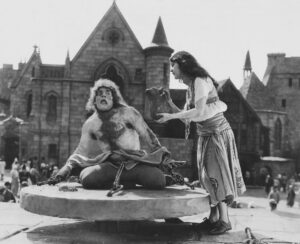It’s time for another classic silent movie! On Tuesday, October 28, at 6 PM, I’ll accompany the 1923 film The Hunchback of Notre Dame at the Plaistow, NH Library. Nearly half the available spaces have already been reserved, so be sure to sign up in advance. The film, based on Victor Hugo’s novel Notre-Dame de Paris, highlights Lon Chaney’s makeup skills and his ability to win empathy for a deformed-looking character.
Hugo’s novel has been adapted many times for film. There were at least four before the Lon Chaney film. Charles Laughton, Anthony Quinn, and Anthony Hopkins are among the actors who have played Quasimodo. Disney turned it into a cartoon and compounded the blasphemy with a sequel where Quasimodo and Esmeralda are still alive. The 1923 version is widely considered one of the best adaptations.
Just by the way, I’ve noticed that the emailed version of these posts delivers the text only to the “More” marker and gives no clue that it’s incomplete. From now on, I’ll add an indicator that there’s more to the post, like this:
…….
 The film is pretty close to the book, as movie adaptations go. The novel is too complex for a movie of less than two hours. There’s an important change from the book, though, and nearly every film adaptation makes it. In the novel, Claude Frollo is the archdeacon of Notre Dame, and to external appearances he’s a worthy holder of the office. However, he’s obsessed with the dancer Esmeralda, and he does horrible things in pursuit of her. The issue of celibate clergy seeking unwilling sexual outlets is still a major issue. In the movie, all of his bad characteristics are transferred to his brother Jehan, who becomes a more important character than he is in the book. It must have been taboo to portray an archdeacon as a sexual predator. Most of the movie adaptations have changed either Claude Frollo’s profession or his character, missing a major point of the novel.
The film is pretty close to the book, as movie adaptations go. The novel is too complex for a movie of less than two hours. There’s an important change from the book, though, and nearly every film adaptation makes it. In the novel, Claude Frollo is the archdeacon of Notre Dame, and to external appearances he’s a worthy holder of the office. However, he’s obsessed with the dancer Esmeralda, and he does horrible things in pursuit of her. The issue of celibate clergy seeking unwilling sexual outlets is still a major issue. In the movie, all of his bad characteristics are transferred to his brother Jehan, who becomes a more important character than he is in the book. It must have been taboo to portray an archdeacon as a sexual predator. Most of the movie adaptations have changed either Claude Frollo’s profession or his character, missing a major point of the novel.
The original film was cut to make it tighter. We don’t know exactly what was omitted. To me, the clearest discontinuity comes after a scene where the Paris underworld nearly hangs the poet Pierre Gringoire until Esmeralda intervenes. In the novel, she marries him to save his life but then makes it clear it’s a marriage in name only. While that’s frustrating for him, it lets him act as a bridge between the underworld and Parisian society. There’s a discontinuity in Gringoire’s arc in the movie, with nothing about what happens to him when he’s saved. He’s a comic relief character in both the book and the movie, and the creators may have thought the audience could only take so much of him.
The ending is changed. In the novel, Esmeralda is executed for a crime she didn’t commit, and Quasimodo’s and Esmeralda’s skeletons are later discovered together, unburied. In the movie, Esmeralda forgets the dying Quasimodo and embraces the glamorous soldier Phoebus. She’s a sympathetic character up to that point, and her action at the end is a letdown.
The set depicting the cathedral is highly impressive, as are the shots where Quasimodo climbs down its outside wall. Stuntmen were used for some of those shots, but whether Lon Chaney or Joe Bonomo did it, it’s amazing.
What stands out most is Chaney’s portrayal of the grotesque Quasimodo, engaging the audience’s sympathy with his actions and expressions. He’s laughed at by most people, mistreated by Jehan, flogged in the public square, and at last shown some sympathy, but he lives and dies without friendship or love.
When I accompany a movie, I try to get inside the characters’ feelings and thoughts. There’s a lot to work with in this one. If you’re in the area of southeastern New Hampshire or northeastern Massachusetts, consider coming over to the Plaistow Library on October 28.